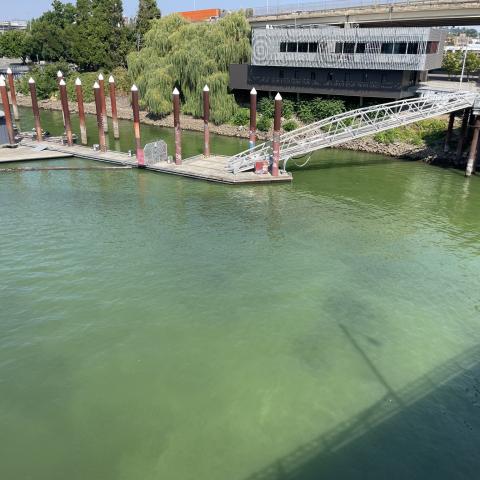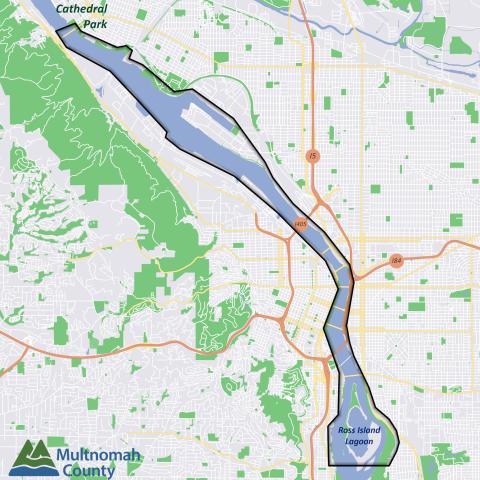Toxic Algae Harmful to Pets Detected
Advisory Locations
- Wednesday, August 16, 2023 - Willamette River - all areas north of Ross Island Lagoon to Cathedral Park
- Monday, August 14, 2023 - Willamette Cove to Cathedral Park
- Friday, August 11, 2023 - Ross Island Lagoon to Riverplace Marina
- Wednesday, August 9, 2023 - Ross Island Lagoon.
- Friday, July 28, 2023 - Willamette Cove.
- Tuesday, July 25, 2023 - Aarons Lake, Pete’s Slough and Sturgeon Lake on Sauvie Island.
More blooms are likely in other bodies of water during summer months. OHA recommends that people be alert for visible signs of toxic algae blooms in all natural bodies of water, and stay out of the water in locations with visible scum. Poisonings are most likely to occur during warm, sunny weather when algae blooms are more intense, and dense surface scums are present. If you find thick, brightly colored foam or scum at a lake, pond or river, don’t let your pet drink or swim in the water.
Risk to Children and Pets
Children and pets are at increased risk for exposure because of their size and levels of activity. Dogs can get extremely ill and even die within minutes to hours of exposure to cyanotoxins by drinking the water, licking their wet fur or eating the toxins from floating mats or dried crust along the shore. This is regardless of a recreational use health advisory in place.
Be aware that dogs can become ill and die from water intoxication after drinking excessive amounts of water while swimming or fetching objects for long periods of time. Intoxication is a potentially fatal disturbance in brain function resulting from an imbalance of electrolytes in the body. Water intoxication and heat stroke can cause similar symptoms as exposure to cyanotoxins.
Symptoms
Exposure to cyanotoxins can be serious and cause a range of symptoms. Symptoms may be similar to food poisoning such as stomach cramping, diarrhea, nausea and vomiting. Symptoms may also be more serious, such as numbness, tingling, dizziness and shortness of breath. These symptoms may require medical attention.
Dogs can experience weakness, difficulty walking, seizures, lethargy, loss of appetite and more. Pet owners should seek veterinary treatment as quickly as possible if their dog exhibits any of those symptoms.
Fishing
Fish caught from areas where cyanobacteria blooms are present may pose unknown health risks, so OHA recommends not eating fish from those sites. Anyone who decides to eat the fish should remove its fat, skin and organs before cooking or freezing. Toxins are more likely to collect in these tissues. Filets should also be rinsed with clean water.
Swimming and High-Speed Boating
People and pets should avoid swimming and high-speed water activities, such as water skiing or power boating, in areas of the river where blooms are, as the major risk of exposure is from ingesting water. These toxins are not absorbed through the skin. However, if you have skin sensitivities you may get a puffy red rash.
Safe Activities
OHA encourages people to visit Aarons Lake, Pete’s Slough and Sturgeon Lake and enjoy activities such as fishing, camping, hiking, biking, picnicking, bird watching, canoeing, and kayaking. Boating is safe as long as speeds do not create excessive water spray. Sprays could lead to the risk of inhaling cyanotoxins.
How Long Will the Advisory Last?
There's no clear end to when the blooms will go away, and they could last for weeks to months. Blooms develop when the water becomes slack and warm, and may last until weather and rains cool the water levels to a point where the blooms can no longer propagate.
Learn more and see current advisory information on the Oregon Health Authority Website
About blue-green algae toxin poisoning
Blue-green algae toxin poisoning, also known as cyanobacterial poisoning, is an acute, sometimes fatal, condition caused by the ingestion of water containing high concentrations of cyanobacteria.
In Oregon, dogs have become very sick, and some have died after swimming in and swallowing water affected by toxic algae.
If your pet is exposed
If your pet goes in the water:
- Don’t let your pet lick its fur.
- Wash your pet with clean water as soon as possible.
- If your dog shows symptoms such as drooling, weakness, vomiting, staggering and convulsions after being in bloom-affected water, seek immediate veterinary care .
Acute, life-threatening symptoms from cyanobacterial toxins often develop rapidly. Death can occur within 4 to 24 hours after exposure.
If you believe you or your pet have been exposed to a cyanobacteria bloom, OHA staff are available to answer health related questions and to receive and document illness reports. For health information or to report an illness, contact OHA at 971-673-0482.
For more information, or to report potential exposure, pet owners are encouraged to visit healthoregon.org/hab .

Multnomah County - DCS - Transportation

Multnomah County Health Department